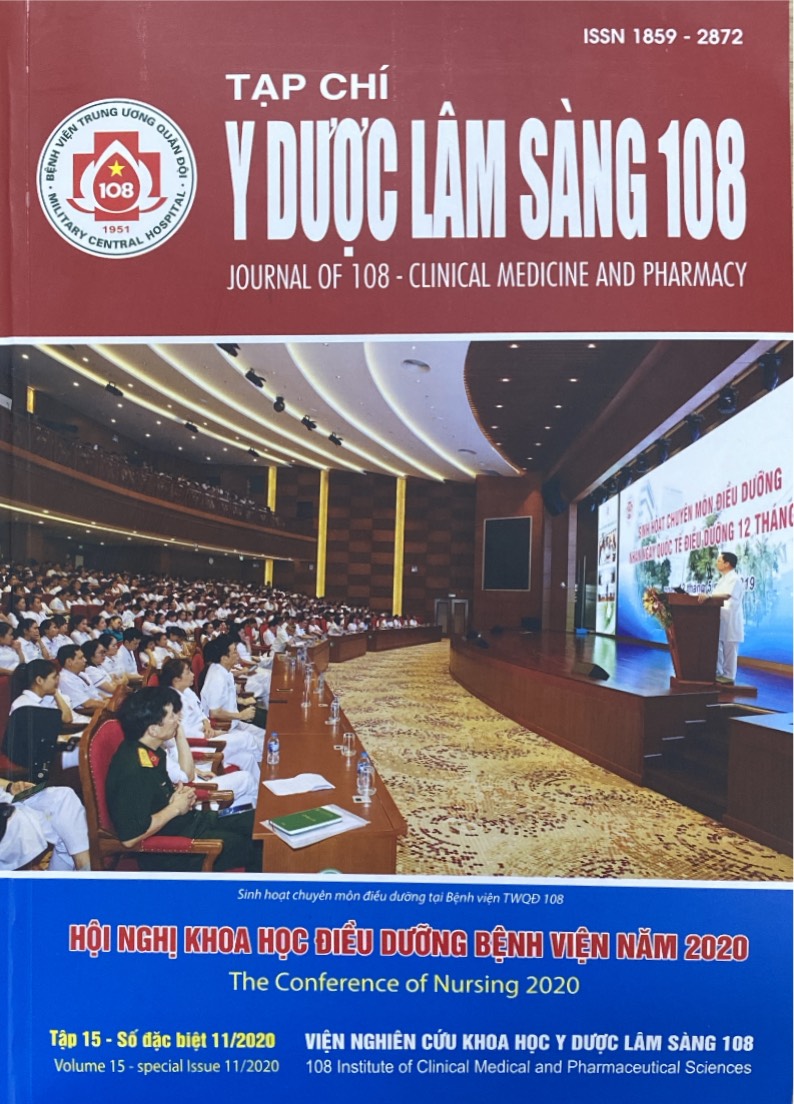Assessment of nutritional status of cancer patients at Department of Pain Management and Palliative Care
Main Article Content
Keywords
Abstract
Objective: To assess the nutritional status of cancer patients when admitted to the hospital for treatment in the Department of Pain Management and Palliative Care. Subject and method: 100 patients entering the Department of Pain management and Palliative Care for the first time were surveyed for a number of clinical indicators, tested and assessed on nutritional status in accordance with the PG-SGA (Scored Patient - Generated Subjective Global Assessment). Result: 68% of patients were male; 63% of patients were ≥ 60 years old; 64% of patients were with gastrointestinal cancer; 82% of patients were in stage IV; 32% of patients had a combination of diseases; and 20% of patients had the systemic status ECOG at 3 points. Assessed on BMI, 19% had light weight, 12% were moderately thin, and 9% were too thin. Assessed on the level of albumin in blood, 21% were of slight decrease, 14% were of moderate and 3% were of severe decrease. Among the 100 patients, 78% suffered from weight loss, 61% suffered from reduced appetite, 62% suffered from activity decrease, 100% suffered from an increase in nutritional requirements, 40% suffered from muscle impairment, fat impairment, and fluid excess. The most common symptoms affecting eating and drinking were: Fatigue (65%), loss of appetite (60%), pain (28%), early satiety (25%). Generally, 11% were in good nutritional status, 58% were in mild malnutrition or moderate malnutrition, 31% were in severe malnutrition. The score group 0 - 1 accounted for 9%, the score group 2 - 3 accounted for 21%, the score group 4 - 8 accounted for 29% and the score group ≥ 9 accounted for 61%. Conclusion: Assessment of the nutritional status of cancer patients when admitted to the hospital for treatment in the Department of Pain management and Palliative Care revealed that 11% were in good nutritional status, 58% were in mild malnutrition or moderate malnutrition, 31% were in severe malnutrition
Article Details
References
2. Eric VC, Jann A (2005) The causes and consequences of cancer-associated malnutrition. European Journal of Oncology Nursing 9(2): 51-63.
3. Bauer J, Capra S, and Ferguson M (2002) Use of the scored patient generated subjective global assessment (PG-SGA) as a nutrition
assessment tool in patients with cancer. Eur J Clin Nutr 56(8): 779-785.
4. Ravi K, Ritesh T, Soumitra N (2015) Evaluation of nutritional status of cancer patients during treatment by patient-generated subjective global assessment: A Hospital-Based study. Asian Pacific Journal of Cancer Prevention 16.
5. Nguyễn Thùy Linh (2020) Hiệu quả can thiệp dinh dưỡng cho bệnh nhân ung thư điều trị hóa chất tại Bệnh viện Đại học Y Hà Nội. Luận án tiến sĩ Y khoa
6. Jessica RL, Ivany AC, Celina SC, Daniel C, Daiane Spitz de S (2019) Applicability of patient-generated subjective Global assessment in palliative care. Hos Pal Med Int Jnl 3(4): 138-145.
7. Nicharach N, Jongjit A, Nicha S, Narin V, Chawalit L Validation of the scored patient-generated subjective global assessment (PG-SGA) in thai setting and association with nutritional parameters in cancer patients. Asian Pacific Journal of Cancer Prevention 20.
8. Nguyễn Thị Hương Quỳnh, Trần Văn Long, Nguyễn Đăng Trường (2018) Đánh giá tình trạng dinh dưỡng của người bệnh ung thư điều trị bằng hóa chất tại Bệnh viện Quân Y 103. Khoa học Điều dưỡng - tập 01 - số 03.
9. Trịnh Hồng Sơn, Nguyễn Bá Anh, Lê Minh Hương, Nguyễn Thanh Long (2013) Đánh giá tình trạng dinh dưỡng của người bệnh trước mổ ung thư dạ dày. Y học thực hành (884) - số 10/2013.
10. WHO : Global Database on Body Mass Index.
 ISSN: 1859 - 2872
ISSN: 1859 - 2872
